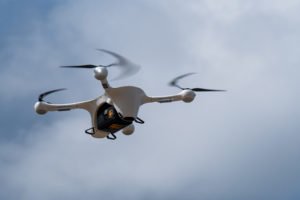
News and Commentary. Federal docket FAA-2023-1256, issued in May, calls for public comments on a proposed rule on four requests for commercial operations beyond visual line-of-sight (BVLOS), performed at or below 400 feet in altitude.
Continue reading below, or listen:
If the permission is granted, says the FAA, “Phoenix Air Unmanned, uAvionix, Zipline, and UPS Flight Forward will continue to expand the envelope of FAA-approved BVLOS drone operations. Data collected from these operations will inform the FAA’s ongoing policy and rulemaking activities.” The request seeks comment on specific aspects of BVLOS drone ops, including detect and avoid, UTM, and shielded operations.
The drone industry has been waiting for an official rulemaking on BVLOS flight for several years. BVLOS flight opens the door to truly remote operations, such as perimeter security or long range infrastructure inspection without humans on site. BVLOS flight would dramatically improve the commercial viability of drone delivery projects, industrial inspections, power line inspections, and more. The BVLOS Aviation Rulemaking Committee (ARC) was formed in June of 2021; the committees findings were published in March of 2022. Still, the FAA has not published a Notice of Proposed Rulemaking (NPRM) on BVLOS flight. Instead, they have ramped up the pace of BVLOS waivers, allowing limited advanced operations in order to gather more data.
The proposed BVLOS permissions for Phoenix Air, uAvionix, Zipline, and UPS Flight Forward could move the rulemaking process forward, providing a bigger data set and proving the safety case. Public comments, however, provide some insight on the pressures that confront the FAA with respect to drone integration.
Comments from drone industry stakeholders tend to offer support for the permissions, or make pertinent suggestions concerning technology or operational guidelines. Comments from the public, and from manned aircraft stakeholder groups, are less positive.
Hot air balloon pilots, paragliders, recreational airplane flyers, and helicopter pilots dominate the comments expressing concern that BVLOS flight permissions below 400 feet pose a serious danger to their operations. Most of these comments point out that less maneuverable vehicles like hot air balloons are at the mercy of faster and more agile vehicles like drones, making the detect and avoid component extremely critical. These comments are legitimate concerns from other stakeholders in the airspace.
Comments from the general public, however, demonstrate that the drone industry still has some work to do in winning over the hearts and minds of the average citizen. Commenters expressed concerns of many types: from predictable worries like noise and privacy issues to less common comments about potential cell phone or Internet service interruptions. Some include adjectives like “dangerous,” “deadly,” or “madness.” Most express fear of having more drones in the airspace.
With fewer than 200 comments currently posted, it’s hard to say if these represent a significant percentage of the public. It is, however, a window into the conflicting pressures facing the FAA: and points out that community engagement is as important as technology when it comes to drone integration.
(Comments on docket FAA-2023-1256 close on June 14, 2023.)
Read more:
- BREAKING NEWS: FAA Releases BVLOS ARC Recommendations
- BVLOS Inspections, No Humans Onsite: Percepto Wins FAA Waiver for Operations Within Shielded Airspace
- uAvionix wins FAA Approval for BVLOS Flights in North Dakota Drone Network: A First for Vantis
- UPS Flight Forward and Matternet M2 Drones Deliver COVID-19 Vaccines
- Zipline and Magellan Rx Partner for Drone Delivery of Prescription Meds to U.S. Homes
- UPS Announces FAA Certification to Operate Drone Airline: “History in the Making”
Miriam McNabb is the Editor-in-Chief of DRONELIFE and CEO of JobForDrones, a professional drone services marketplace, and a fascinated observer of the emerging drone industry and the regulatory environment for drones. Miriam has penned over 3,000 articles focused on the commercial drone space and is an international speaker and recognized figure in the industry. Miriam has a degree from the University of Chicago and over 20 years of experience in high tech sales and marketing for new technologies.
For drone industry consulting or writing, Email Miriam.
TWITTER:@spaldingbarker
Subscribe to DroneLife here.